Boom or bust aren't the only NBA outcomes for Edey
After dominating the NCAA over the last two seasons, Purdue big man Zach Edey’s NBA viability is the draft’s most fascinating debate.
Some wonder how a slow-footed giant can avoid being run off the floor in the Association’s pace-and-space era. Others can’t understand why a youngster so historically prolific at the collegiate level couldn’t translate that success to the pros.
Of course, boom or bust aren’t the only possible outcomes, and the likeliest scenario will see the 7-foot-4 Toronto-born center land somewhere between those two extremes.
It’s true that the modern game doesn’t leave much room – or minutes – for bigs like Edey.
The best of them can stretch the floor on one end, protect the rim on the other, and move their feet when guarding in space or switched onto perimeter players. Will Edey do any of those things well at the NBA level? After camping out in the paint at Purdue, the NBA’s defensive three-second rule means even protecting the rim will be a new challenge for him. Teams will test the 300-pounder’s mobility and lateral quickness by putting him in pick-and-rolls and running five-out lineups.
Edey’s length and size can only make up for so much, and it’ll take him time to adjust to the league’s speed and frenetic movement. But that sheer size helps. His heft and nearly 7-foot-11 wingspan will still serve as a deterrent to opposing drivers. Playing in the right drop scheme, he’s bound to have some defensive utility.
However, most of Edey’s NBA potential lies on the offensive end.

Edey’s offensive diet won’t be as post-up heavy as it was at Purdue. But his physical advantages in the post and on the offensive glass, footwork, surprisingly soft touch, and catch-radius as a pick-and-roll and lob finisher should enable him to be a legitimate force on that end as soon as next season. In time, he can be a potential nightmare for opposing defenses.
His interior presence, vertical spacing, and improving court-vision should create good looks for the 3-point shooters around him. There’s also reason to believe the shooting mechanics are there for Edey to expand his own range as a pro after attempting just two 3-pointers in four years at Purdue. Edey was a 71% free-throw shooter on outrageous volume last season, with the gap between his NCAA-leading 436 free-throw attempts and the player with the second-most tries equivalent to the space between the second- and 88th-ranked players.
Edey will also have to continue working on his left hand, but his track record is one of rapid development. We’re talking about a guy who had barely picked up a basketball before starting to play in Grade 10 and who was the 75th-ranked center (358th-ranked overall) in his college recruiting class. You don’t go from that to being one of the most dominant players in NCAA history just by being big.
Edey became the first player since Ralph Sampson 41 years ago – and just the fifth player ever – to win back-to-back AP National Player of the Year awards. He joined Kareem Abdul-Jabbar and Bill Walton as the only players to record 35 points and 10 rebounds in an NCAA men’s championship game. He’s the first college player to average at least 24 points, 12 rebounds, and two blocks in 27 years. Add in the improved playmaker’s two assists per game this season, and no player in Basketball Reference’s 32-year NCAA database can match his overall stat line. Zion Williamson is the only other baller to post a 40-plus PER, as Edey did in his sophomore and junior years.
There’s not much precedent for a player dominating boxscores as Edey did without them turning into at least a solid NBA rotation player.
In what’s touted to be the weakest draft class in more than a decade, how many teams can afford to pass on Edey’s floor?
There are legitimate reasons to question whether he can develop into an All-Star caliber player in the modern NBA, but he will get buckets, demand double-teams, and devour rebounds. And he’s getting better.
Just because Edey’s not going to be as effective as Yao Ming, it doesn’t have to mean he’ll be as limited or as much of a gimmick as Boban Marjanovic. And Marjanovic, who didn’t reach the NBA until he was 27 years old, has still made nearly $40 million over a nine-year career.
Joseph Casciaro is theScore’s senior content producer.


